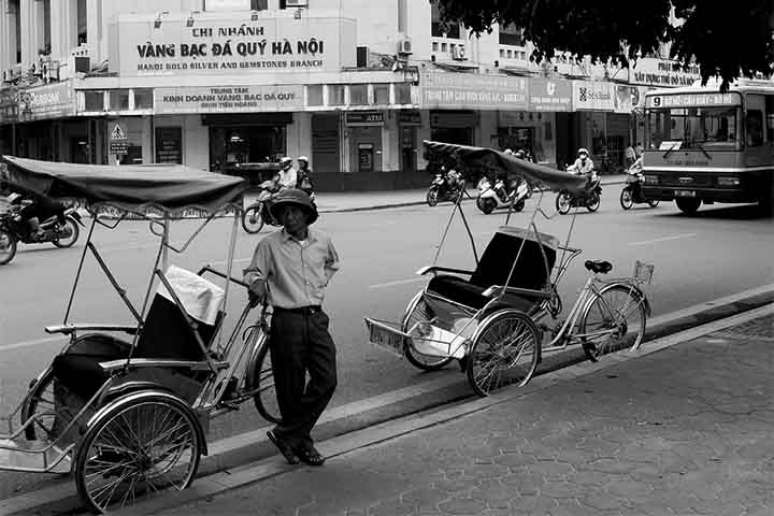-
Throughout history, human-powered vehicles have been widely used in Asian countries. Among them are India, Japan and China, nations where the famous rickshaws helped to make short trips and move around the city. Currently this means of transport has acquired new versions with modernity.
Photo: Image by Richard Xu from Pixabay / Flipar
-
At some point, these vehicles were banned in some countries due to accidents and were replaced by cycle rickshaws. These are powered like a bicycle, but in some configurations they can be equipped with an electric motor.
Photo: Flickr Bill Barber / Flipar
-
The traditional rickshaw is a human-powered means of transport in which one individual pulls a two-wheeled cart that can accommodate one or two other people.
Photo: Image by Alexander Gounder from Pixabay / Flipar
-
The word originates from Asia, where the vehicle was widely used as a means of transportation by the elite. However, they have now been banned in many countries on the continent due to numerous accidents, despite the resistance of those who were avid consumers.
Photo: Image Michelle Raponi Pixabay / Flipar
-
As a result, as exemplified, they have been replaced, especially in Asia, by cycle rickshaws. In addition, these vehicles are also common in Western cities such as New York, USA. In London, for example, they are known as pedicabs.
Photo: Gryffindor/Wikimedia Commons/Flipar
-
The term “rickshaw” comes from the Japanese word jinrikisha, which literally means “human-powered vehicle”. In this sense, this means of transport first appeared in the painting “Les deux carrosses” by the artist Claude Gillot, from 1707.
Photo: Creative Commons/Flipar
-
For this reason it became known as vinaigrette due to its resemblance to the wheelbarrows of the vinegar makers of the 17th and 18th centuries. The popularization of buses as public transportation eventually reduced the use of rickshaws shortly after World War II.
Photo: Image by Ron James from Pixabay / Flipar
-
Rickshaws appeared in Japan around 1868, at the beginning of the Meiji Restoration. They quickly became a popular means of transportation because they were faster than the sedan chairs previously used.
Photo: Public domain/Wikimedia Commons/Flipar
-
However, the identity of the inventor of this vehicle remains uncertain. Some sources cite the American blacksmith Albert Tolman, who is credited with inventing the rickshaw around 1848 in Worcester, Massachusetts for a missionary.
Photo: Public domain/Wikimedia Commons/Flipar
-
Others, however, maintain that Jonathan Scobie (or W. Goble), an American missionary from Japan, invented rickshaws around 1869 to transport his invalid wife along the streets of Yokohama.
Photo: Terence/Wikimedia Commons/Flipar
-
Furthermore, Japanese sources often give credit to Izumi Yosuke, Suzuki Tokujiro, and Takayama Kosuke, who they say invented rickshaws in 1868. They were inspired by the horse-drawn carriages that had been introduced to Tokyo streets shortly before.
Photo: Pixabay image / Flipar
-
Beginning in 1870, Tokyo authorities granted these three men permission to manufacture and sell traditional rickshaws. The signature of one of these inventors was also required on all licenses to operate the vehicle.
Photo: Image by govaayu from Pixabay / Flipar
-
By 1872, around 40,000 rickshaws were in use in Tokyo. They soon became the country’s main form of public transport. Years later, these vehicles appeared in India, first in Simla and 20 years later in Calcutta.
Photo: Arnaud-Victor Monteu/Wikimedia Commons/Flipar
-
In 1914 the Chinese asked for permission to use rickshaws for passenger transportation. Soon afterward they appeared in many of the large cities of Southeast Asia.
Photo: Image by Md Faysal Ahmed from Pixabay / Flipar
-
Rickshaws, known as pousse-pousse, are a very common means of transportation in several cities in Madagascar. They are usually brightly decorated.
Photo: Bernard Gagnon/Wikimedia Commons/Flipar
-
These vehicles in Bangladesh are pedal-powered and are available for rent throughout the country. The country’s capital, Dhaka, is sometimes called the “rickshaw city.”
Photo: Tony Cassidy/Wikimedia Commons/Flipar
-
Cycle rickshaws also became popular in Malaysian cities in the 1970s. Since then, rapid urbanization has increased the demand for more efficient public transportation, resulting in a decline in the number of traditional rickshaws.
Photo: flickr Goosmurft / Flipar
-
In 1997 a new rickshaw system was created in Berlin. It is a modern looking vehicle (CityCruiser) and allows drivers to use it as an advertising medium. In about ten years the business with CityCruisers has advanced worldwide.
Photo: SlaveToTheWage/Wikimedia Commons/Flipar
-
The many Zulu rickshaw drivers, with their huge hats and colorful clothes, are one of the major attractions for tourists in the South African city of Durban. In Brazil, cycle rickshaws are used in the cities of Rio de Janeiro and Volta Redonda and are better known locally as ecotaxis.
Photo: Reproduction social network / Flipar
-
In many major cities in the United States, bicycle rickshaws have been in use for about a decade. Rickshaws are also present on the boardwalk in Atlantic City, New Jersey, transporting gamblers from one casino to another.
Photo: Flickr veloform / Flipar
-
Hong Kong rickshaws were first imported from Japan in 1874. They were a popular vehicle for years, reaching over 3,000 in the 1920s. However, their popularity declined after World War II.
Photo: Image by Markus Winkler from Pixabay / Flipar
-
Hand rickshaws began to be used in China in the late 1800s, but most disappeared after 1949. By the early 1990s, cycle rickshaws had become a cheap and popular means of transportation. In Vietnam, rickshaws are used as a means of transportation in central areas.
Photo: Image by Thomas G. from Pixabay / Flipar
-
Since 2005, the last significant fleet of these authentic vehicles has been in Kolkata, where the rickshaw drivers’ union has opposed the ban. There are 60 million users of e-rickshaws (electric versions), as these models are called,
Photo: Arnaud-Victor Monteu/Wikimedia Commons/Flipar
-
One of the major advantages of the new rickshaws is that they reduce air pollution, even though they burden traffic. The government has given subsidies to owners who exchange their old models for non-polluting ones,
Photo: Image from Pexels by Pixabay / Flipar
-
The vehicle has already appeared in several films and series, especially those shot in Asia, the continent with the largest number of rickshaws in the world. The 1953 Bollywood film “Do Bigha Zameen”, directed by Bimal Roy, depicts the fate of a poor farmer to become a rickshaw puller in Calcutta.
Photo: Flickr Talley1144 / Flipar
-
The rickshaw was also part of the soap opera “Caminho das Indias”, on Rede Globo, written by the author Glória Perez. During the recordings, some of the actors of the soap opera traveled around the country aboard this very traditional vehicle.
Photo: reproduction/TV Globo / Flipar
-
Cycle rickshaw is a small-scale means of transportation. It is used for rental, equipped with one or more seats to carry passengers, in addition to the driver. They are found in large urban centers, tourist attractions and events.
Photo: Image by Guillermo Gavilla from Pixabay / Flipar
-
The vehicle is moved by the driver as if it were a bicycle, although some configurations are equipped with an electric motor to assist the driver. Typically it is a tricycle, although some quadricycle models exist and some bicycles with trailers are configured as rickshaws.
Photo: Flickr frogMob / Flipar
-
Cycle rickshaws are used in most major cities. They are used in major European cities such as London, Barcelona, Budapest, Berlin, Edinburgh, Frankfurt, Hamburg, Amsterdam, Copenhagen, Milan and Rome. London. In North America, San Diego and New York are home to hundreds of re-sending.
Photo: Youtube / Flipar playback
Share
Source: Terra
Rose James is a Gossipify movie and series reviewer known for her in-depth analysis and unique perspective on the latest releases. With a background in film studies, she provides engaging and informative reviews, and keeps readers up to date with industry trends and emerging talents.







